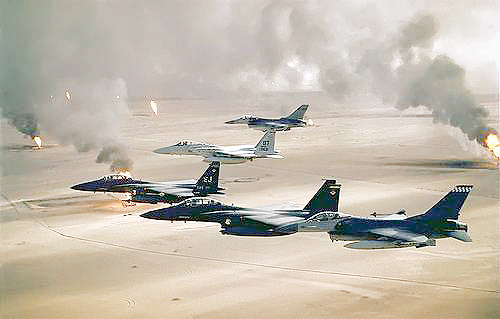
KUWAIT: On the morning of January 17, 1991, warplanes and helicopters of a UN-authorized international coalition launched massive air attacks on Iraqi targets to signal the start of a military campaign, code-named Operation Desert Storm, to evict Iraqi forces out of Kuwait. The operation came after the failure of all diplomatic means to persuade Iraq to pullout troops and end illegal occupation of Kuwait which started on 2 August, 1990.
On the same day of the Iraqi invasion, the United Nations Security Council (UNSC), upon a request from Kuwait and the United States, held an emergency meeting to discuss the Iraqi move and passed Resolution 660 condemning the invasion and demanding Iraq withdraw immediately and unconditionally to positions as they were on August first, 1990. On November 29, 1990, the UN Security Council passed Resolution 678 which gave Iraq until January 15, 1991 to withdraw from Kuwait and empowered states to use 'all necessary means' to force Iraq out of Kuwait after the deadline. Three days before the end of the UN ultimatum to Iraq, the US Congress passed on 12 January a joint resolution authorizing the use of US military force to expel Iraqi forces from Kuwait.
1,200 sorties
In the first day of Operation Desert Storm, the coalition jets conducted 1,200 sorties, including 302 by Saudi and Kuwait aircraft, destroying almost half of the Iraqi airpower. The US aircraft carriers launched 100 Tomahawk missiles against Iraqi sites and forces in Iraq and Kuwait. US F-17 aircraft struck numerous targets in Baghdad and hit Iraqi communication networks. British Tornado bombers attacked Iraqi airports, and French and Italian jetfighters pounded the Iraqi missile launching sites. Kuwaiti fighters attacked Iraqi targets inside Kuwait.
After suppressing the Iraqi air defenses and communication centers, the coalition aircraft bombarded Iraq's Scud missile launchers, military research centers, navy ships, and forces inside Kuwait. Later, the coalition forces struck Iraq's TV and Radio building and started throwing circulars on Iraqi forces demanding them to quit the battlefield or surrender to the coalition forces. On February 22, Iraq agreed on a Soviet Union proposal for withdrawing forces from Kuwait in three weeks under the supervision of the United Nations, but the US rejected it and announced 24 hours ultimatum to Iraqi forces to completely pullout of Kuwait or face a ground operation.
Ground operation
On February 24, the ground operation commenced when coalition forces advanced and attacked Iraqi forces in Kuwaiti cities and in southern Iraq. The United States had contributed 1,800 jetfighters, 1,700 helicopters and 100 warships including six aircraft carriers to the international coalition for the liberation of Kuwait. Nearly 500,000 American personnel participated in Kuwait's liberation war, making up almost two thirds of the total number of the coalition forces, estimated at 750,000.The Arab forces in the coalition were estimated at 200,000 and the British and French forces were 30,000 and 13,000 respectively.
Kuwait's air forces had played a significant role in the liberation war as it assumed the responsibility of attacking Iraqi forces inside Kuwait in an effort to protect Kuwaiti people's valuable possessions. It also targeted airports used by Iraqi forces, artillery sites and Iraqi forces assembly areas. On February 26, at dawn, the Iraqi army started pullout from Kuwait after setting ablaze Kuwaiti oilfields. On February 27, 1991, US President George HW Bush announced end of the military campaign and the liberation of Kuwait after 100 hours from the start of the ground operation. - KUNA










